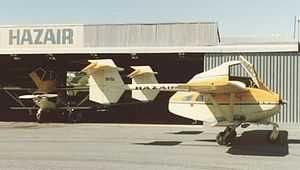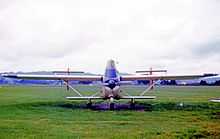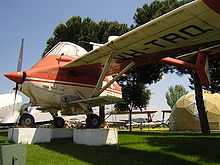Transavia PL-12 Airtruk
| PL-12 Airtruk | |
|---|---|
 | |
| PL-12 Airtruks of Hazair at Albury airport, New South Wales, in March 1988 | |
| Role | Agricultural aircraft |
| National origin | Australia |
| Manufacturer | Transavia Corporation |
| Designer | Luigi Pellarini |
| First flight | 22 April 1965 |
| Produced | 1966-1993 [1] |
| Number built | 118 |
| Developed from | Bennett Airtruck |
The Transavia PL-12 Airtruk is a single-engine agricultural aircraft designed and built by the Transavia Corporation in Australia. The Airtruk is a shoulder-wing strut braced sesquiplane of all-metal construction, with the cockpit mounted above a tractor engine and short pod fuselage with rear door. The engine cowling, rear fuselage and top decking are of fibreglass. It has a tricycle undercarriage, the main units of which are carried on stub wings. It has twin tail booms with two unconnected tails. Its first flight was in 22 April 1965, and was certified on 10 February 1966.[2]
Design and development

It was developed from the Bennett Airtruck designed in New Zealand by Luigi Pellarini. It has a 1 metric ton capacity hopper and is able to ferry two passengers as a topdresser. Other versions can be used as cargo, ambulance or aerial survey aircraft, and carry one passenger in the top deck and four in the lower deck.
The Airtruk is also sometimes known as the Airtruck. Because the name "Airtruck" was registered by the New Zealand companies Bennett Aviation Ltd and Waitomo Aircraft Ltd, for their PL-11, Transavia found another name for their PL-12 ("Airtruk").
July 1978 saw the first flight of an improved model, the T-300 Skyfarmer, which was powered by a Textron Lycoming IO-540-engine. This was followed in 1981 by the T-300A with improved aerodynamics.[2] Transavia ceased production of the T-300 in 1985.
In 1982 certification was undertaken to enable sales in the North American market. Assistance was provided by the Aeronautical Research Laboratories (ARL) of the Defence Science and Technology Organisation (DSTO) and extensive tests carried out on the ground and in subsequent flight flutter clearance trials. ref. DSTO Structures Tech. Memo. 341
In 1985 an extended version was produced and released as the T-400. The engine was changed from a 6-cylinder to an 8-cylinder and the tail booms extended by 750 millimetres. Other minor changes were made to the aerodynamics. Flutter clearance tests were again carried out by ARL and manufacture proceeded.[3]
An isolated flutter incident was reported in 1986 involving violent oscillations of the rudder and tail boom on the T-400 during a delivery flight. Investigations were carried out by ARL and a split mass balance arm was fitted to each rudder. Prior to this the aircraft had relied on frictional damping provided by the lengthy control cables. The modified aircraft was tested both on the ground, and in flight trials in March 1988 over Port Philip near Melbourne, Australia. All attempts to induce the oscillations showed that there was no indication of a mode of vibration becoming unstable. The maximum speed achieved was 160 knots in a steep dive. Oscillations were induced with an air operated tool fitted with an out-of-balance rotating mass. This device had a rotational speed from 18 Hz down to zero for each charge of the compressed air cylinder.[4]
At least 120 had been built by 1988.[2]
Operations and survivors
The PL-12 was famously seen in the 1985 movie Mad Max Beyond Thunderdome.
As of 2008, there are at least three examples in museums in New Zealand, with an additional one being restored to airworthy status. The second prototype is preserved in the Powerhouse Museum collection, Sydney, Australia.[5]
There is one Transavia PL-12 Airtruk on display and under restoration at the Danish Air Museum at the airport called "Stauning" in western Denmark.[6]
There is one airworthy Airtruk in Ecka airfield near Zrenjanin, Serbia and one in Albury, Australia.
Variants

- PL-12 Airtruk
- Single-engined agricultural aircraft. Powered by 300 hp (224 kW) Rolls Royce Continental IO-520-D
- PL-12U
- Multi-purpose utility transport, air ambulance, aerial survey aircraft.
- T-320 Airtruk
- Powered by a 320-hp Continental/Rolls-Royce Tiara 6-320-2B piston engine.[7]
- Skyfarmer T-300
- Powered by Lycoming O-540 engine.
- Skyfarmer T-300A
- Improved version of the T-300.
- Skyfarmer T-400
- Enlarged, more powerful (400 hp (298 kW) Lycoming O-720 engine. [2]
- PL-12 MIL
- Proposed multi-role utility transport, air ambulance, forward air control, light attack, counter-insurgency aircraft. Also known as the M-300.[8]
- PL-12 550T
- Proposed variant powered by a 550-hp Pratt & Whitney Canada PT6A turboprop engine.[8]
Specifications (T-300A)
Data from Jane's All the Worlds Aircraft 1988-89 [2]
General characteristics
- Crew: 1
- Capacity: 907 kg (2,000 lb) dry chemicals or 818 litres (216 US Gallons, 180 Imp Gallons) liquids. Two passengers.
- Length: 6.35 m (20 ft 10 in)
- Wingspan: 11.98 m (39 ft 3½ in)
- Height: 2.79 m (9 ft 2 in)
- Wing area: 24.5 m² (264 ft²)
- Airfoil: NACA 23012
- Empty weight: 1,017 kg (2,242 lb)
- Max. takeoff weight: 1,925 kg (4,244 lb)
- Powerplant: 1 × Textron Lycoming IO-540-K1A5 flat-six piston engine, 224 kW (300 hp)
Performance
- Never exceed speed: 274 km/h (148 knots, 170 mph)
- Maximum speed: 196 km/h (106 knots, 122 mph) at 915 m (3,000 ft)
- Cruise speed: 188 km/h (102 knots, 117 mph) (max cruise -75% power)
- Stall speed: 73 km/h (39 knots, 45 mph)
- Range: 1297 km (700 nm, 806 mi)
- Service ceiling: 6,890 m (22,600 ft)
- Rate of climb: 7.62 m/s (1,500 ft/min)
- Wing loading: 78.6 kg/m² (16.1 lb/ft²)
- Power/mass: 0.12 kW/kg (0.071 hp/lb)
References
Notes
- ↑ "The Transavia Airtruk & Skyfarmer" Airliners.net. Retrieved 27 October 2013.
- ↑ 2.0 2.1 2.2 2.3 2.4 Taylor 1988, p.7.
- ↑ Goldman, A.; Galea, S. Flutter clearance tests on a Transavia PL-12/T-400 Skyfarmer. Melbourne: Aeronautical Research Laboratories. ISBN 9780642097453.
- ↑ Goldman, A.; Rider, C.D.; Piperias, P. ARL-STRUC-TM-515 Flutter investigations on a Transavia PL12/T-400 aircraft. Melbourne: Aeronautical Research Laboratory.
- ↑ Transavia Airtruk PL-12, Australia, 1965, VH-TRN Powerhouse Museum. Retrieved 3 August 2008.
- ↑ http://flymuseum.dk/
- ↑ Taylor 1977, p.8.
- ↑ 8.0 8.1 Donald 1997, p.877.
Bibliography
- Donald, David (editor). The Encyclopedia of World Aircraft. Leicester, UK: Blitz, 1997. ISBN 1-85605-375-X.
- Taylor, John W R. (editor). Jane's All the Worlds Aircraft 1976-77. London:Jane's Yearbooks, 1976. ISBN 0-354-00538-3.
- Taylor, John W R. (editor). Jane's All the Worlds Aircraft 1988-89. Coulsdon, Surrey, UK: Jane's Information Group, 1988. ISBN 0-7106-0867-5.
External links
| Wikimedia Commons has media related to Transavia PL-12 Airtruk. |
- Discussion on the PL-12 in New Zealand aviation forum
- Transavia PL-12 Airtruk, kiwiaircraftimages.com
| ||||||||||||||||||||||